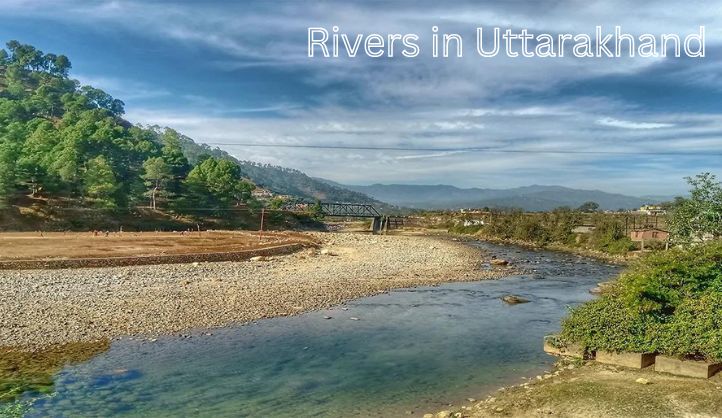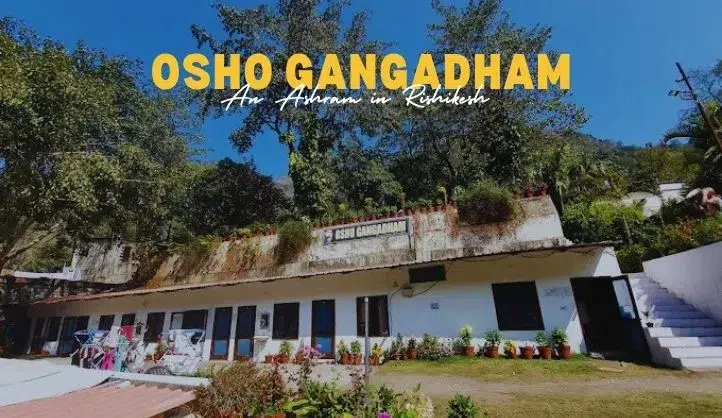Rivers in Uttarakhand:
Many Rivers in Uttarakhand. The Ganga is the most important, starting from Gangotri and flowing through the state. The Yamuna starts at Yamunotri and joins the Ganga. The Bhagirathi and Alaknanda join to become the Ganga at Devprayag. The Mandakini is clear and flows through Rudraprayag. Pindar River comes from Pindari Glacier, and Saraswati River meets Alaknanda at Keshav Prayag. These rivers make Uttarakhand beautiful and special. People visit them for their beauty and cultural importance.
Ganga (Ganges):
Uttarakhand is blessed with the sacred Ganga, originating from the Gangotri Glacier. As the holiest river in Hinduism, the Ganga traverses the state with grace, passing through spiritual hubs like Haridwar and Rishikesh. Its journey through the plains of North India symbolizes purity and spiritual cleansing. Pilgrims from across the country and beyond seek the divine essence of the Ganga, participating in religious ceremonies and taking holy dips in its revered waters. The Ganga is not merely a river; it is a source of spiritual solace and a lifeline for the communities along its banks.
- Origin: Gangotri Glacier in Uttarakhand.
- Flow: It traverses Uttarakhand, passing through cities such as Haridwar and Rishikesh. The river then continues its journey through the northern plains of India.
- Significance: Revered in Hinduism, the Ganga is considered sacred, and its waters are used in various religious ceremonies.
Yamuna:
Emerging from the pristine Yamunotri Glacier, the Yamuna is a significant river in Uttarakhand. Its course, running parallel to the Ganga, symbolizes the cosmic companionship of two sacred rivers. Pilgrims undertake arduous journeys to the Yamunotri, where the river finds its source, to pay homage to the goddess Yamuna. The confluence of the Yamuna and the Ganga at Prayagraj is a focal point for religious activities, where devotees believe that a dip in the confluence cleanses them of sins. The Yamuna, with its mythological significance, adds to the spiritual aura of Uttarakhand.
- Origin: Yamunotri Glacier in Uttarakhand.
- Flow: Running parallel to the Ganga, the Yamuna flows through Uttarakhand and meets the Ganga at the Triveni Sangam in Allahabad (Prayagraj).
- Significance: The Yamuna is also a sacred river in Hinduism, and its confluence with the Ganga is considered auspicious.
Bhagirathi:
The Bhagirathi River, originating at the Gangotri Glacier, is one of the primary headstreams of the Ganga. Its journey through the rugged terrains of Uttarakhand is not just a geographical phenomenon but a saga of devotion and mythology. Named after King Bhagirath, the river is believed to be the result of his penance to bring the Ganga to Earth. The confluence of the Bhagirathi with the Alaknanda at Devprayag marks a sacred union, giving birth to the revered Ganga. The Bhagirathi stands as a testament to the deep spiritual connection between humanity and the rivers in Uttarakhand.
- Origin: Gangotri Glacier in Uttarakhand.
- Flow: The Bhagirathi is one of the two main headstreams of the Ganga. It joins the Alaknanda at Devprayag to form the Ganga proper.
- Significance: Named after King Bhagirath, the Bhagirathi holds mythological importance, as it is believed that King Bhagirath’s penance led to the descent of the Ganga to Earth.
Alaknanda:
The Alaknanda, originating at the confluence of the Satopanth and Bhagirathi rivers in Mana village, is a majestic tributary of the Ganga. Its course through the Garhwal region is adorned with breathtaking landscapes and holds religious significance. The Alaknanda joins the Bhagirathi at Devprayag, creating the Ganga, and the confluence is considered a divine site. Pilgrims embark on the Char Dham Yatra, visiting the sacred shrines along the Alaknanda, seeking blessings and spiritual rejuvenation. The river, with its glacial origins, brings both life-sustaining waters and divine inspiration to the heart of Uttarakhand.
- Origin: Confluence of the Satopanth and Bhagirathi rivers at Mana village in Uttarakhand.
- Flow: The Alaknanda is the other primary headstream of the Ganga. It joins the Bhagirathi at Devprayag to form the Ganga.
- Significance: Like the Bhagirathi, the Alaknanda is a sacred river, and the confluence at Devprayag is a revered pilgrimage site.
Mandakini:
The Mandakini River, a tributary of the Alaknanda, gracefully flows through the Rudraprayag district in Uttarakhand. Known for its crystal-clear waters, the Mandakini enhances the region’s natural beauty. Pilgrims on the Char Dham Yatra encounter the Mandakini’s serene presence, and the confluence of the Mandakini with the Alaknanda is considered auspicious. The river, with its purity and tranquility, reflects the spiritual essence that characterizes Uttarakhand’s riverine landscape.
- Flow: A tributary of the Alaknanda, the Mandakini flows through the Rudraprayag district in Uttarakhand.
- Characteristics: Known for its crystal-clear waters, the Mandakini adds to the natural beauty of the region.
Pindar River:
Originating from the Pindari Glacier in the Kumaon region, the Pindar River is a tributary of the Alaknanda. Its journey through the breathtaking landscapes of Uttarakhand adds to the region’s ecological diversity. The Pindar River, with its glacial origins, carries pristine waters, contributing to the overall river system. The river is not only a geographical feature but a vital component of the delicate Himalayan ecosystem, sustaining life and biodiversity in its flow.
- Origin: Pindari Glacier in the Kumaon region of Uttarakhand.
- Flow: A tributary of the Alaknanda, the Pindar River contributes to the complex river network in Uttarakhand.
Saraswati River:
Joining the Alaknanda at Keshav Prayag, the Saraswati River is a tributary that plays a part in the intricate river network of Uttarakhand. While its flow is not as voluminous as some of the other rivers, the Saraswati holds its own significance in local mythology. Its confluence with the Alaknanda adds to the dynamic nature of the river system, symbolizing the interconnectedness of Uttarakhand’s waterways. The Saraswati, named after the Hindu goddess of knowledge and wisdom, contributes to the spiritual and cultural richness of the region.
- Confluence: Joins the Alaknanda at Keshav Prayag.
- Significance: The Saraswati is a tributary adding to the flow of the Alaknanda.
Yamunotri River:
The Yamunotri River, emerging from the Yamunotri Glacier, holds a special place in the hearts of pilgrims and nature enthusiasts alike. Its source is not just a geographical point but a sacred pilgrimage site where devotees embark on a spiritual journey to pay homage to the river goddess Yamuna. The river’s flow is symbolic of purity and divinity, contributing to the larger Yamuna River. Surrounded by the pristine beauty of the Himalayas, the Yamunotri River is a testament to the delicate balance between the spiritual and natural elements that define Uttarakhand.
- Origin: Emerging from the Yamunotri Glacier.
- Flow: Feeding into the Yamuna, the Yamunotri River is a significant contributor to the overall river system in the region.
- Pilgrimage: The source of the Yamunotri River is a key pilgrimage site for Hindus, attracting devotees seeking the blessings of the river goddess Yamuna.
Tons River:
Originating from the Tons Glacier, the Tons River is a powerful tributary of the Yamuna, carving its way through the rugged terrains of the Garhwal region. Known for its challenging rapids, the Tons River has become a haven for adventure seekers seeking the thrill of white-water rafting. Beyond its adventurous appeal, the river is an integral part of the ecological tapestry, sustaining diverse flora and fauna along its course. The Tons River, with its untamed spirit, adds an element of excitement to the serene landscapes of Uttarakhand.
- Origin: Tons River originates from the Tons Glacier.
- Flow: It is a major tributary of the Yamuna and flows through the rugged terrains of Garhwal region, offering breathtaking landscapes.
- Adventure: The Tons River is known for its challenging rapids, making it a popular destination for white-water rafting enthusiasts.
Dhauliganga:
Flowing from the Niti Pass, the Dhauliganga River contributes to the majestic river network in Uttarakhand. Its course through the Dhauliganga Valley is marked by stunning vistas and remote wilderness. This river, while not as widely recognized, plays a vital role in shaping the geography of the region. The Dhauliganga, with its glacial origins, serves as a lifeline for the communities along its banks, offering sustenance and a source of livelihood for the people dwelling in the remote Himalayan landscapes.
- Origin: Begins at the Niti Pass.
- Flow: A tributary of the Alaknanda, it flows through the scenic Dhauliganga Valley, contributing to the overall river system of Uttarakhand.
Nandakini River:
Originating from the Nanda Devi Sanctuary, the Nandakini River is a major tributary of the Alaknanda. Its journey through the Chamoli district unfolds against a backdrop of towering peaks and lush greenery. The Nandakini is not merely a watercourse; it is a conduit of life, nurturing the biodiversity of the region. The river’s crystal-clear waters and the pristine environments it flows through exemplify the untouched natural beauty that defines Uttarakhand.
- Origin: Originates from the Nanda Devi Sanctuary.
- Flow: It is a major tributary of the Alaknanda, flowing through the Chamoli district, offering serene landscapes.
Kali River:
Arising in the Pithoragarh district, the Kali River serves as the eastern boundary between India and Nepal before merging with the Ghaghara River in the plains. The Kali River, with its strategic geographical location, not only contributes to the regional river system but also plays a role in the cultural and economic ties between the two neighboring countries. Its journey through the varied landscapes of Uttarakhand reflects the interconnected nature of the region’s river networks.
- Origin: Arises in the Pithoragarh district.
- Flow: It serves as the eastern boundary between India and Nepal before joining the Ghaghara River in the plains.
Conclusion:
Uttarakhand, adorned with the crown of the Himalayas, is graced by a symphony of rivers that not only carve through its breathtaking landscapes but also carry the cultural and spiritual heritage of the region. From the revered Ganga, originating from the Gangotri Glacier to the lesser-known but equally significant rivers like the Dhauliganga and Kali, each watercourse contributes to the ecological diversity, adventure opportunities, and religious sanctity of this northern Indian state.
These rivers serve as lifelines, not only sustaining the flora and fauna but also providing spiritual nourishment to the people who dwell in their proximity. Uttarakhand’s rivers are not merely bodies of water; they are conduits of life, reflecting the delicate balance between nature and spirituality that defines this enchanting region.
FAQs (Frequently Asked Questions):
What is the significance of the confluence of the Bhagirathi and Alaknanda at Devprayag?
The confluence of the Bhagirathi and Alaknanda at Devprayag marks the sacred union where these two rivers merge to form the Ganga. This site holds immense religious importance, drawing pilgrims who believe that a dip in the confluence cleanses them of sins.
Are there adventure activities associated with Uttarakhand’s rivers?
Yes, Uttarakhand is a hub for adventure activities, particularly white-water rafting. Rivers like the Tons and Yamuna offer thrilling rapids, attracting adventure enthusiasts from around the world.
What is the Char Dham Yatra, and how are the rivers associated with it?
The Char Dham Yatra is a pilgrimage to four sacred shrines in Uttarakhand. The journey involves visiting Yamunotri, Gangotri, Kedarnath, and Badrinath, all of which are located along the banks of the state’s significant rivers—Yamuna, Ganga, Mandakini, and Alaknanda.
How do the rivers of Uttarakhand contribute to the state’s biodiversity?
The rivers of Uttarakhand sustain diverse ecosystems along their banks, providing habitats for various flora and fauna. These watercourses contribute to the region’s rich biodiversity, supporting a range of plant and animal species.
What is the cultural significance of the Saraswati River in Uttarakhand?
While the Saraswati River is not as voluminous as some others, its confluence with the Alaknanda holds cultural importance. Named after the Hindu goddess of knowledge, Saraswati, the river contributes to the spiritual richness of Uttarakhand.









